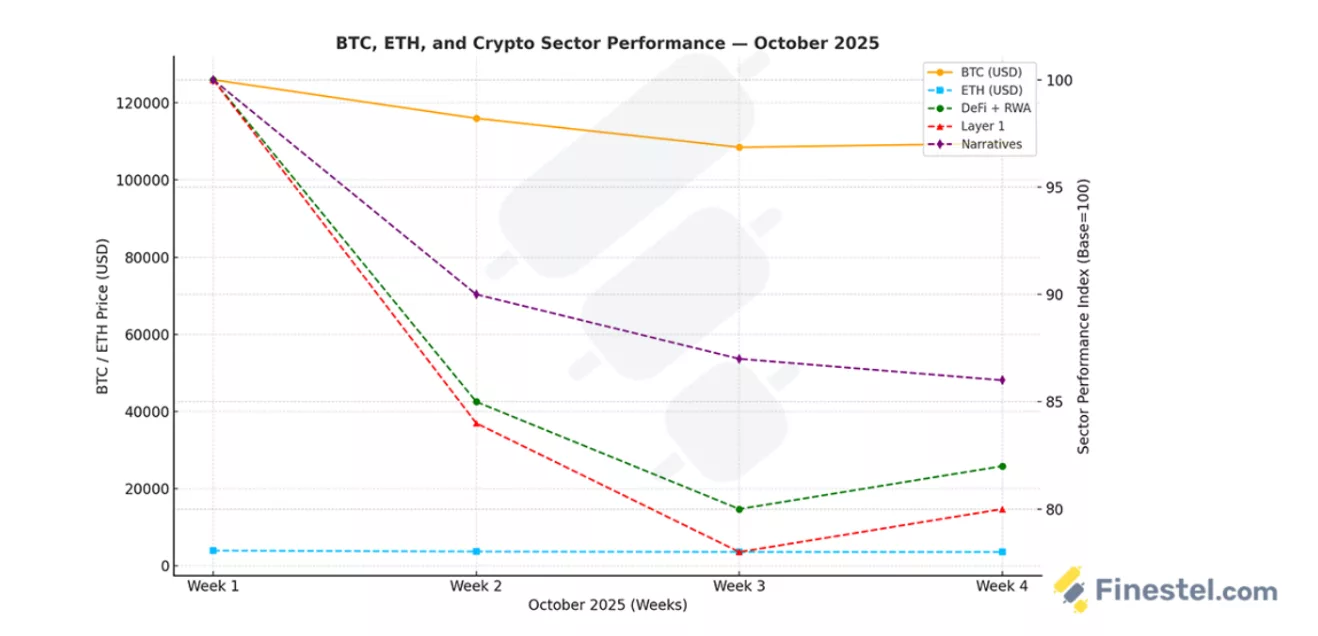October tested crypto markets as BTC and ETH held firm while most altcoins dropped over 80% amid volatility. Whales raised BTC and ETH allocations to 50.1%, added $2.8 billion in stablecoins, and shifted about 300,000 BTC as support moved to $108,000.
Summary
- October was a wild month for crypto as Bitcoin hit $126,000 before dropping 13% in a day and closing around $115,000, while Ethereum stayed near $4,600 and most altcoins lost over 80%.
- Professionals pulled back from risky bets, raising BTC and ETH allocations from 48.2% to 50.1%, stablecoins from 19.8% to 20.5% with $2.8 billion inflows, and trimmed altcoins to 13.6%.
- Even with big swings, about 300,000 BTC changed hands, support levels moved up to $108,000-$110,000, and institutions kept buying strategically during dips.
Crypto markets went all over the place in October as professional investors pulled back from risky bets and focused on Bitcoin (BTC) and Ethereum (ETH) while uncertainty built up.
Bitcoin started the month at $126,000 before falling 13% in one day, its biggest drop in six months, which analysts at Finestel called the “biggest liquidation event in history.”

In a monthly analytical research report shared with crypto.news, Finestel noted that even with the sell-off, the market ended October a bit higher. Bitcoin closed around $115,000, up 4.5% for the month, while Ethereum stayed near $4,600, up 3%. Yet, most altcoins got hit hard, with some losing more than 80% in corrections.
Macro signals
sThe month had a lot of mixed signals as the U.S. government shutdown, ongoing since Sept. 30, ran into Trump‘s tariff threats, regional bank problems, and changing Fed policy.
“The whipsaw was brutal. If you felt confused this month, that’s because the market was genuinely pricing in contradictory signals.”
Finestel
Early October was rough as Trump targeted Chinese edible oils with tariffs while denying broader 100% tariff reports. Meanwhile, financial lenders like Zions and Western Alliance reported fraud losses and worries about credit spread across risk assets.
Bitcoin wasn’t immune to this and fell along with stocks. However, relief came slowly as a Gaza ceasefire on Oct. 14, China-U.S. trade talks on Oct. 18, and China buying U.S. soybeans on Oct. 28 eased selling pressure.
Eventually, Trump suggested cutting fentanyl-related tariffs by 50% and the Fed cut rates 25 basis points on Oct. 29, hinting at ending quantitative tightening sooner, which could put more money back into risk markets. As Finestel notes, September CPI came in at 3%, which is below the 3.1% expected, with markets now expecting two more cuts in 2025, though the government shutdown still leaves gaps in the data.
Crypto trenches
Under the surface, the market held up better than the price moves showed. Long-term Bitcoin holders barely moved, while short- and medium-term holders who bought near $108,000-$124,000 sold during the crash.
As a result, about 300,000 BTC changed hands in busy trading ranges, while support levels moved up from $104,000-$112,000 early in the month to $108,000-$110,000 by late October. As Finestel said, this reallocation is bullish because the correction “reset structure at higher levels rather than breaking it.” At the same time, Bitcoin dominance rose from 58% to 59.48%.
Ethereum stayed steady largely thanks to staking, as yields of 608% with 30% participation gave a floor during corrections. Platforms like Lido and EigenLayer kept seeing inflows, while tokenized real-world assets on Ethereum, especially through Pendle, nearing $7 billion total value locked, gave institutions a way to earn yield safely.

According to data shared in Finestel’s report, core BTC and ETH holdings rose from 48.2% to 50.1% of portfolios, while stablecoins went up to 20.5% from 19.8%, with $2.8 billion inflows. The decentralized finance market and tokenized assets fell slightly to 15.8% from 16.2%, keeping yield but cutting riskier bets.
Altcoins dropped to 13.6% from 15.8%, with a focus on Solana (SOL) and Avalanche (AVAX). As risk limits tightened, max loss per position held at 7-9% and portfolio value-at-risk stayed under 9%, with the analysts adding that “after watching 82% of liquidations hit long positions during the correction, leverage ratios fell to yearly lows even as prices recovered.”
What’s next
Institutional activity stayed steady as spot Bitcoin ETFs had $1.4 billion in inflows early October, the second-highest weekly total ever. Corporate treasuries added about 15,000 BTC through Bitdeer and Hut 8, with the analysts saying that the pattern is clear as institutions keep accumulating Bitcoin as a “treasury asset, but doing it tactically during dips rather than chasing highs.”
However, Finestel expects more ups and downs around economic data and trade news. U.S. reports on Nov. 7, including jobs, trade, and factory numbers, will be watched closely after the shutdown, while delayed PCE inflation could affect Fed plans. Other than that, China-U.S. talks could also bring a deal or summit and lift risk appetite, while EU and UK stablecoin rules may also help markets.
Bitcoin staying above $108,000 could let it move back toward $120,000 or higher, but tariffs or weak labor data could push it down. Professional positioning calls for about 52% BTC/ETH, 19-20% stablecoins, 16% DeFi/RWA yield assets, and 12-13% selective altcoins, including Solana, Avalanche, and AI-linked tokens.
As Finestel explained, October “tested resilience and professionals responded by concentrating capital in quality assets, building cash positions, and using defined-risk strategies rather than leverage,” adding that the correction likely got rid of extra speculation and reset support higher.



